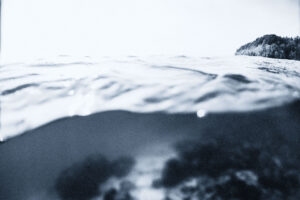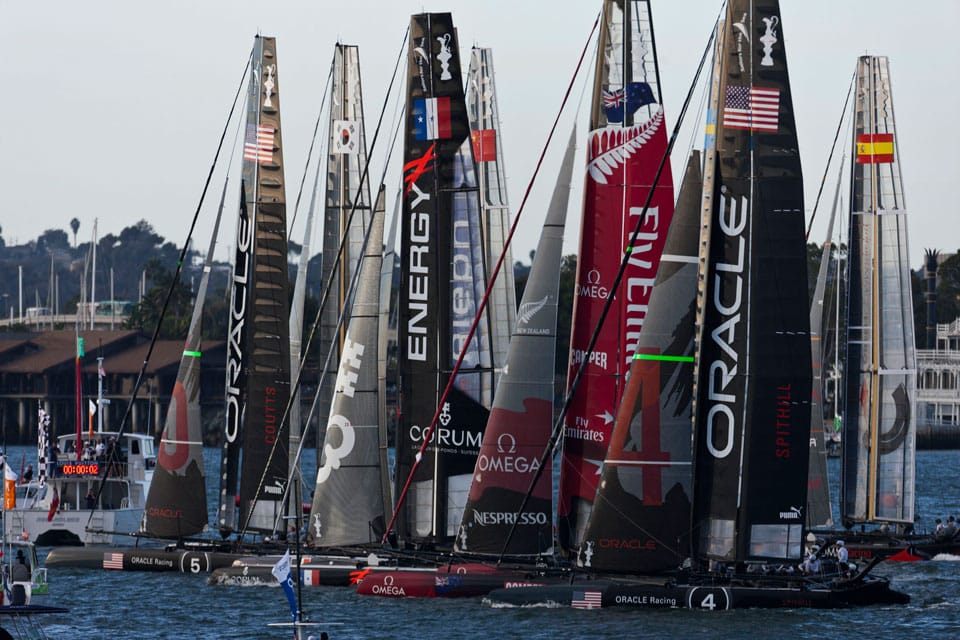
AC34 World Series
Last November I went to the America’s Cup World Series event in San Diego to see the extraordinary technology being used to manage and broadcast the racing, and it worked so well that I came home a full-fledged fan. But don’t presume that you have to be a tech enthusiast to appreciate the 34th Cup as it plays out around the world over the next 18 months. This time the tech innovations are more about building a fast and fair playing field, which focuses on pure sailing skills. Forget that sailboat races are like watching paint dry; AC34 can be as gripping and intimate as high-definition close-ups of the Patriots and Giants battling for Super Bowl rings.
Before you pull up the America’s Cup YouTube channel to see some of the footage already generated, it helps to learn a bit about the technology behind the scenes, and the history too. The Cup has always been an unusual competition, because the winner gets to manage the next round of racing. Many of the unsuccessful challengers would argue that the New York Yacht Club maintained its dominance by manipulating the rules, but worse things happened once the Cup started bouncing around the globe in 1983.
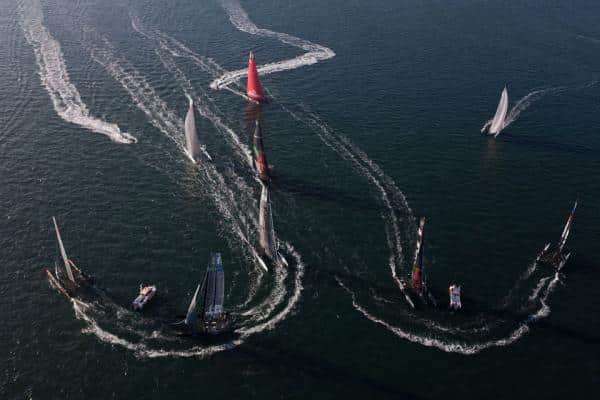
View a complete photo gallery of the America’s Cup World Series here.
The event hit bottom during the 2007-to-2010 round, when the Swiss defender couldn’t or wouldn’t come up with boat design and racing rules the American “challenger of record” thought reasonable. As a result, the competition took place mostly in courtrooms and culminated with dull racing held far offshore in mismatched and teched-up multihulls. It didn’t help the sport’s popularity that the two small yacht clubs involved were obvious fronts for aggressive billionaires. In retrospect, though, one can picture how challenger Team Oracle — led by Oracle Corp. founder and serious yachtsman Larry Ellison — used the agonizing delays of AC33 to get charged up about what it could do with AC34.
In fact, as soon as Oracle had won the Cup off Spain, Ellison’s crew rapidly created large, talent-rich and well-funded AC34 management organizations, which reconceived the next round in every way. The concept, more NFL than NYYC, is unapologetic professional racing in extreme boats on tight courses close to shore, stadium style. The main San Francisco event in 2013 — to be raced in custom 72-foot catamarans capable of speeds of more than 30 knots — would be preceded by a first-ever AC “World Series” fought in a fleet of matching 45-foot carbon cats so lively that the athletes on board, including many veterans of Olympic small-boat racing, often work at maximum pulse rates. There’s also a challenging tactical component to short-course racing this fast, plus a dash of NASCAR, since the AC45s can suddenly nosedive, flip or even cartwheel when seriously powered up. Hence the crash helmets.
This concept took, and by the time the ACWS reached San Diego after races in Portugal and England, it included eight sponsored teams representing perennial challengers like New Zealand and France along with new ones like China and Korea. And crack teams from Italy and the UK will join the starting lines when the series makes port in Naples and Venice, Italy, and Newport, Rhode Island, in the months ahead. AC34 chartered a cargo ship to cart the 45s, 25 support vessels and umpteen containers of gear. The kit even includes tall cranes to put the ultralight cats to bed on windy evenings lest they fly off their moorings! So, yes, Larry Ellison and company have proved themselves darn serious about reinventing the America’s Cup. Here’s a look at how technology is helping.
Ultra Telemetry
No one has attempted to manage and umpire sailboat racing that’s as intense as the AC34 World Series. How, for instance, can an umpire consistently call early starts when they involve a dozen very quick boats, each with two bows and a bowsprit and which are driven by experts at getting over the line first? The key component is a gray Frisbee-size NovAtel GPS located exactly on center at each AC45’s stern. Using an onshore reference station set up by America’s Cup race management (ACRM), this GPS is accurate to better than an inch 10 times a second, no matter how the AC45 dances. Now imagine this level of position and motion information combining with similarly accurate heading, heel and pitch data and then zipping ashore via ACRM’s private high-power Wi-Fi network, and you’ll start to fathom the ultra telemetry underlying AC34.
Indeed, while thousands of humans intently watch the racers, a computer farm whirring away in a windowless container is better at “seeing” where they are. Meanwhile, similarly accurate telemetry is coming from the support fleet, especially the mark boats that define the ends of the start and finish lines and other course elements. The chief umpires are also in a container, intently monitoring a special tracking program. They also have numerous video feeds and are in touch with colleagues on personal watercraft chasing the racers — ACRM is thorough, and prepared for system failures too — but the telemetry technique is working very well. For instance, high-definition starting line videos purportedly demonstrate that boats just two inches over the line have been penalized while boats two inches behind weren’t.
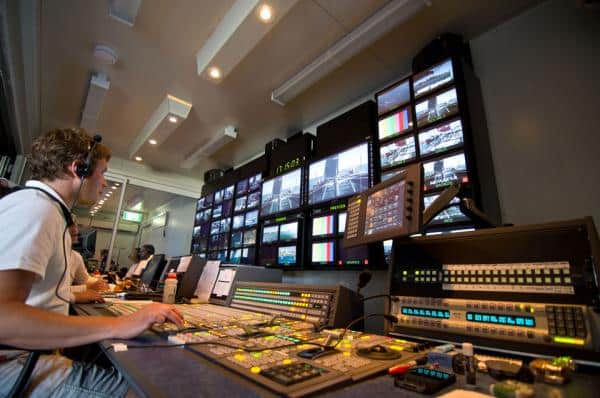
I’m told that one result of ACRM’s ultrafair umpiring system is that the sailors are spending less time and energy arguing about race incidents. ACRM is not only helping them focus, but also has done away with dreaded post-race protests altogether and is using its data network to modernize the racing in many other ways. Bright flashing LEDs placed strategically on the cats but run by the umpires quickly called penalties, which were announced to racers and fans. The LED signal network also oversees the mostly virtual boundaries, ensuring that spectators will never again see a Cup match racer maneuver its opponent over the horizon — boring! The virtual boundaries also let spectator vessels stand in close to the action.
In fact, ACRM can change the boundaries and marks on the fly, both to keep races on schedule (consider that, network TV) and to realign the upwind and downwind gates in shifting conditions so that the tactical decision about whether to go left or right out of one is all the more challenging. This dynamic course setting is possible because the mark boats maintain position with their outboards instead of anchors — the second generation will use dynamic positioning — and because the race master can push new course geometry out to the mark fleet instantly. This is where Garmin got deeply involved with AC34.
First chosen as the electronics supplier to the support fleet, Garmin later became an AC34 partner and had an engineering team work with ACRM. That’s why each of the mark boats, and many of the other boats in the support fleet, has two large Garmin touch-screen displays. One is networked to standard radars, depth sounders, etc. and used for regular navigation, while the other uses ACRM’s wireless network to track all the AC vessels and the course. The support fleet also carries networked ultrasonic wind sensors (though the racers have to use their eyes). So on the committee boat, principal race officer John Craig can monitor wind conditions all over the course and if needed tweak the location of a race gate on a dedicated PC program that will then calculate the total course time for a typical AC45. If the change looks good, Craig then submits the new course to the network, it pops up on all the ACRM Garmins, and the mark boats move as needed.
I got an impressive demonstration of this first-ever high-tech race management, and Garmin is justifiably proud of its involvement. Moreover, while I was aboard the committee boat, Garmin management and ACRM staff were discussing how at least parts of the system could be adapted for other sail events. And there are more ways that AC34 technology may trickle down to recreational boating — for instance, wouldn’t you like to know to the accuracy enjoyed by AC umpires where the kids took your tender? — but I have yet to explain the most spectacular result of AC34’s ultra telemetry.
LiveLine
To turn the America’s Cup into a truly gripping professional sport, perhaps the greatest challenge is broadcasting it so that we can feel the adrenaline flowing on the cats and understand what the heck is going on. AC34 equipped each race boat with four remote-control HD cameras and more than a dozen microphones. In San Diego there were also three camera helicopters, multiple camera boats and a maze of containers that looked like ESPN studios inside. But the secret sauce is a new technology called LiveLine.
Previous broadcasts often cut away to gamelike virtual simulations of the race to illustrate the lay of the course, which boat was ahead and the tactics in play. That helped, and in fact one ACTV container houses the same simulation experts, though now their work is largely a backup in case the much trickier LiveLine fails. That’s because LiveLine — which overlays the boat’s name, speed, distance to mark and much more right on top of live helicopter video — is the perfect complement to the race narrators but is almost ridiculously difficult to do.
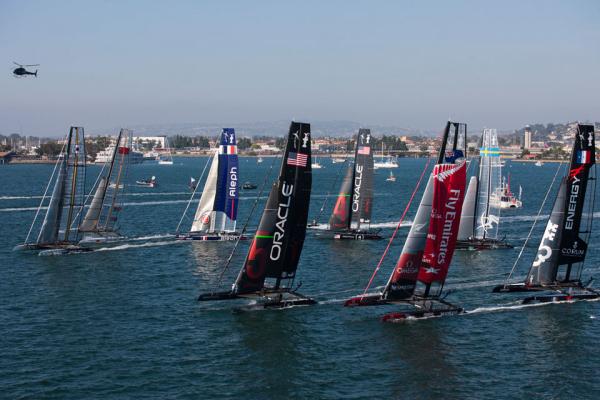
Frankly I’m still impressed with the yellow first-down line overlay that was so useful watching the Super Bowl, even though I’ve learned how it’s done. A video processing computer knows exactly where the camera is relative to the field’s geometry and to wireless sensors built into the down markers. The turf color is treated as a reverse mask, and thus the processor knows to lay the digital yellow line only over green, and it ends up looking like it was magically painted on the field. You’ve probably seen similar overlay magic done with hockey pucks, NASCAR racers and strike zones, but consider the dynamics of LiveLine with the camera in a helicopter and all the race elements so far away that even a miniscule geometry error will lead to an obvious overlay mismatch.
So LiveLine is where AC34’s latest boat and course telemetry really pays off, and apparently the helicopter is tracked with 10 times more precision in all directions than the boats are. Who put all this together? No less than the same team that invented the yellow down line and many other professional sport enhancements, which happens to be headed by a gentleman who is also an expert sailor. Check out “Stan Honey, Sailor-Geek Extraodinaire” to read about AC34 Director of Technology Stan Honey and say hallelujah for the existing fans of the America’s Cup and the new ones to come.
I don’t know if AC34 will succeed in its goal of turning ordinary Americans into fans, but I’m convinced that anyone who’s ever had a passing interest in how wind on the water can become speed and sport should zero in on the new Cup. I’m also aware that some sailors fear that once AC34 moves up to the bigger boats it might again become a battle of competing technologies and maybe even lawyers, but I have a different theory.
Larry Ellison may be one of the most competitive guys on earth, but wouldn’t a second Cup victory be sweetest if won on an ultrafair playing field in front of a huge crowd? In fact, I think Ellison may become a boating hero, not for winning the Cup once, twice or more, but for making it a truly great sporting event. Let’s watch and find out!
To view more photos of the America’s Cup World Series, click here.
Author’s note: Ben Ellison is not related in any way to Larry Ellison but is Yachting_’s electronics editor._

